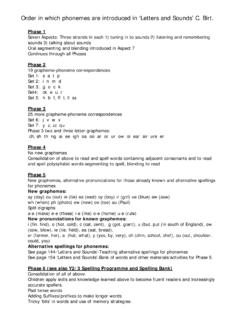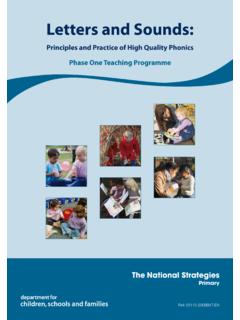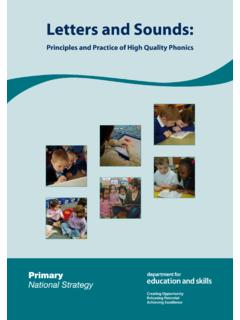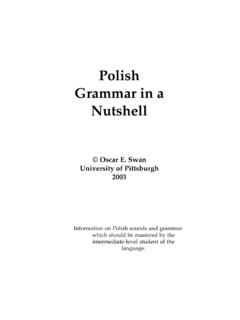Transcription of Letters and Sounds, Phase 1, Aspect 2 - YorOK Website
1 Letters and Sounds, Phase 1, Aspect 2 General sound Discrimination Instrumental Sounds Tuning into Sounds Main Purpose: To experience and develop awareness of sounds made with instruments and noise makers. Preparation Organise an area so that the children sit facing a screen. Ensure there one set of instruments behind the screen and room for an adult or child Resources Two sets of identical instruments A screen Activity 2 Which instrument? Give the children the opportunity to play one set of instruments to introduce the sounds each instrument makes and name them all.
2 Ask one child to hide behind the screen and choose one instrument from the identical set to play. The rest of the group have to identify which instrument has been played. Develop the activity by playing a simple rhythm or adding a song to accompany the instrument while the hidden instrument is played. This time the children have to concentrate very carefully, discriminating between their own singing and the instrument being played. Look, listen and note how well children: Identify and name the instruments being played Listen and respond as the instrument is being played Share with parents: Save an empty box or use a clothes maiden or chair.
3 Collect some items from around the house wooden bricks, pan lids, metal/wooden dishes and spoons. Take tries and turns to make the noises from behind the box Letters and Sounds, Phase 1, Aspect 2 General sound Discrimination Instrumental Sounds Tuning into Sounds Main Purpose: To experience and develop awareness of sounds made with instruments and noise makers. Preparation Symbols to represent loud and quiet will require preparation in advance. Ensure instruments are in good order Resources Symbols or resources to represent loud and quiet Selection of instruments Look, listen and note how well children: Identify and name the instruments being played Listen and respond as the instrument is being played Activity 3 Adjust the volume Two children sit opposite each other with identical instruments.
4 Ask them to copy each other making loud sounds and quiet sounds. It may be necessary to demonstrate with two adults copying each other first. Then try with an adult and one child. Use cards or puppets as cues to represent loud or quiet ( picture of a megaphone or a finger on the lips or a puppet of a lion and a mouse). Share with parents: This is an easy game to play at home using items from around the home. Letters and Sounds, Phase 1, Aspect 2 General sound Discrimination Instrumental Sounds Tuning into Sounds Main Purpose: To experience and develop awareness of sounds made with instruments and noise makers.
5 Letters and Sounds, Preparation A large floor space, outdoors would be ideal for this game. Resources A selection of instruments Look, listen and note how well children: Identify and name the instruments being played Listen and respond as the instrument is being played Activity 4 Grandmother s footsteps Grandmother has a selection of instruments and the children decide what movement goes with which sound ( shakers for running on tip-toe, triangle for fairy steps, drum for giant strides).
6 First an adult will need to model being Grandmother. Then a child takes the role. Grandmother stands with her back to the others and plays an instrument. The other children move towards Grandmother in the manner of the instrument while it is playing. They stop when it stops. The first person to reach Grandmother takes over the role and the game starts again. Share with parents: Children will still enjoy playing this game even with only two people. A teddy or dolly can also join in the fun. Letters and Sounds, Phase 1, Aspect 2 General sound Discrimination Instrumental Sounds Listening and Remembering Sounds Main Purpose: To listen and appreciate the difference between sounds made with instruments Preparation Space for children to sit in a small circle.
7 Area to place screen if required Resources Pairs of matching sound makers Feely bag Screen ( to adapt game) Look, listen and note how well children: Are able to remember and repeat a rhythm Discriminate and reproduce loud and quiet sounds Are able to start and stop playing at the signal Activity 5 Matching sound makers Show pairs of sound makers ( maracas, triangles) to a small group of children. Place one set of sound makers in a feely bag The children take turns to select a sound maker from the feely bag.
8 Once all the children have selected a sound maker, remind them to listen carefully. Play a matching sound maker. The child with that sound maker stands up and plays it. Adapt the activity by playing the sound maker behind a screen so the children have to identify it by the sound alone. Share with parents: Use a shopping bag or basket to hide sound makers in. Take tries and turns. Can you find something that makes a sound like Child can have 3 or 4 items to choose from. Letters and Sounds, Phase 1, General sound Discrimination Instrumental Sounds Listening and Remembering Sounds Main Purpose: To listen and appreciate the difference between sounds made with instruments Letters and Sounds, Phase 1, Preparation Space for the children to sit in a small circle.
9 Resources Selection of percussion instruments Look, listen and note how well children: Are able to remember and repeat a rhythm Are able to start and stop playing at the signal Activity 6 Matching sounds One child starts the game by playing an instrument. The instrument is then passed round the circle and each child must use it to make the same sound or pattern of sounds as the leader. Start with a single sound to pass round the circle, and then gradually increase the difficulty by having a more complex sequence of sounds or different rhythms Share with parents: Knock on wood to make simple patterns the bed head.
10 Say a simple rhyme: Mummy taps like this (tap, tap) Andy taps like that (tap, tap). Mummy knocks like this ( knock, knock) Andy knocks like that (knock, knock). Letters and Sounds, Phase 1, Aspect 2 General sound Discrimination Instrumental Sounds Talking about Sounds Main Purpose: To use a wide vocabulary to talk about sounds instruments make. Preparation Identify stories from which the text lends itself to using instruments Along came the giant ( drum beat for footsteps) Resources Appropriate story books.











